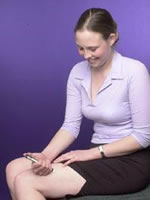Type 1 and Type 2 diabetes
There are two types of diabetes. In both, the body cannot regulate the level of glucose in the blood. This is because the body either stops producing the hormone insulin or does not respond properly to the insulin that is being made.

This model shows the structure of insulin. It is a complex protein hormone.
Image courtesy of: T. Blundell & N. Campillo / Wellcome Images
|
Type 1 diabetes
|
Type 2 diabetes
|
|---|---|
|
Usually develops before the age of 20, with a peak at 12 years
old.
|
Usually appears after the age of 40.
|
|
Pancreas stops making
insulin.
|
Pancreas makes reduced amounts of insulin, or the body does not
respond normally to the insulin produced.
|
|
Treatments include insulin injections, diet control and regular
exercise.
|
Treatments include diet control, medication and regular exercise.
|
|
About 10% of diabetes cases.
|
About 90% of cases.
|
|
Also called insulin-dependent diabetes mellitus (IDDM)
|
Also called non-insulin dependent diabetes
|
Symptoms: develop quickly. Tiredness, excessive urine production, weight loss, increased thirst and blurred vision. |
Symptoms: same as for type 1 but less severe and may go undetected for many years. |
What causes diabetes?
Diabetes does not have just one cause. Many factors influence whether a person develops diabetes or not. These include lifestyle, diet and genetic make-up.
Type1 diabetes

Injecting insulin allows diabetics to control their blood sugar levels.
Type 1 diabetes is an auto-immune disease. The person's immune system attacks the cells in the pancreas that make insulin. These cells are called the islets of Langerhans. The immune system destroys them as if they were an infection. Insulin production is quickly and dramatically stopped.
People with type 1 diabetes often have a particular form of a gene that is involved in the production of cell-recognition proteins. They trigger the immune system to destroy the insulin-producing cells.
It may soon be possible to develop a genetic test to identify people who are at a high risk of developing type 1 diabetes. It may even become possible to replace the faulty gene using gene therapy .
Type 2 diabetes
Obesity , and a lack of physical exercise, are linked to an increased likelihood of developing type 2 diabetes. It is more likely to develop if people have a diet that contains lots of saturated fats, sugar and is low in fibre. Some insulin production continues but the liver and body cells do not respond to it normally.
Question 1
Male aged 52 who is over weight and takes little exercise.

Girl aged 9 who has a history of diabetes in her family.

















